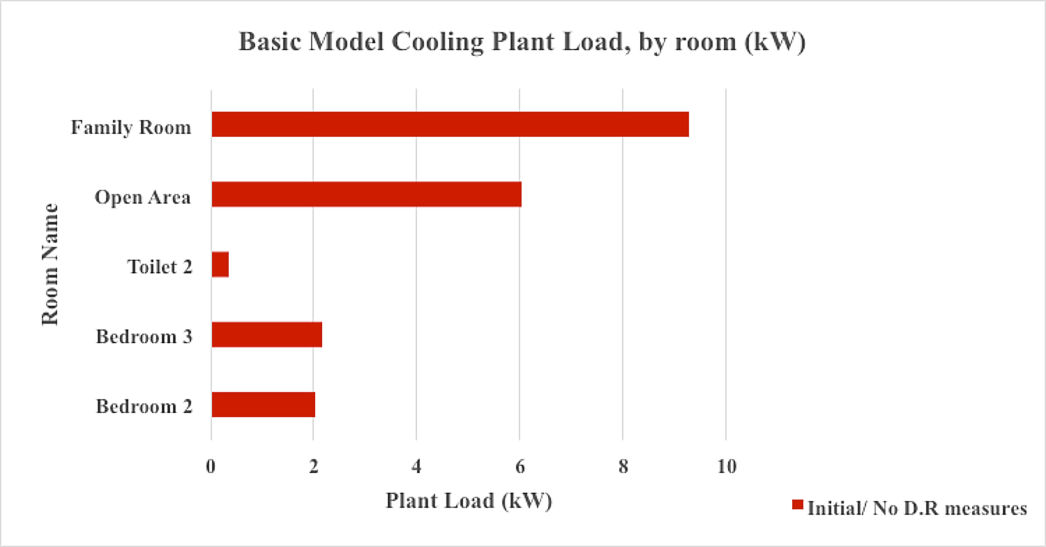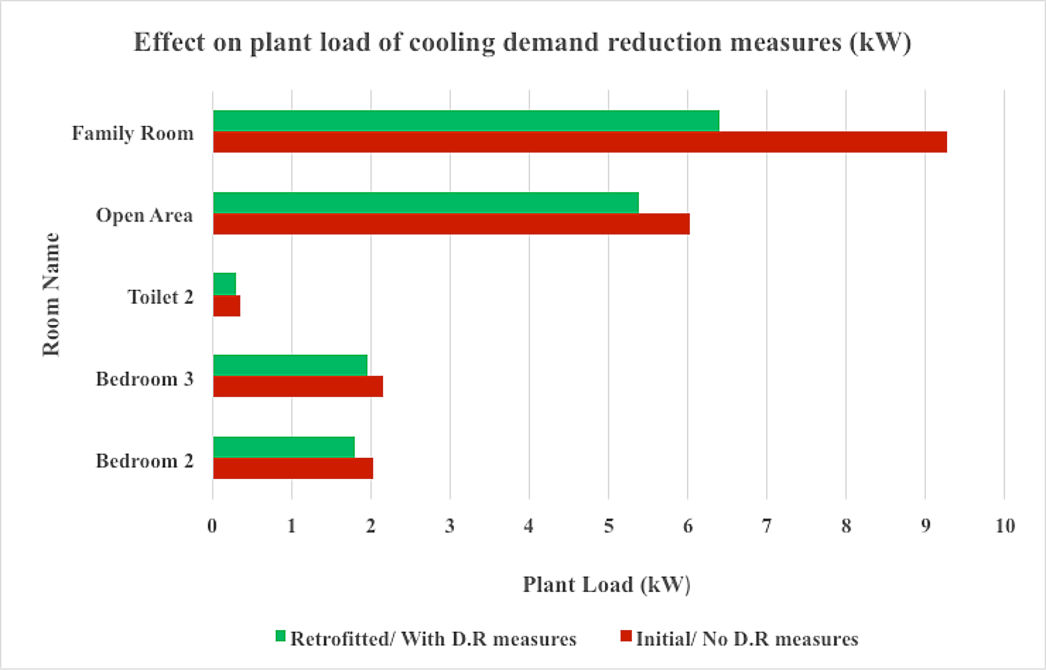
The effect of cooling demand reduction measures was analysed by applying them into the dynamic IESVE model, and then assessing their effects on reducing the thermal gains and cooling requirements of the A/C system.
There were three combined primary cooling-related measures proposed: installing a high solar reflectance façade [cool roofs; cool walls], and also increasing thermal resistance through insulation.
Initially, baseline model data was gathered to assess the current cooling energy demand of the simulated house, and to compare reduction measures against. For the purposes of this model, 5 rooms were implemented with cooling plant- the family room, and the entire first floor.
Figure 1 below, extrapolated from IESVE, displays this annual peak cooling demand profile for the rooms selected (peak load occurs in June), and it is observable that there is a 19.85 kW total plant load at this time. Ideally the plant should be sized to meet high (summer) load periods, which is the case here.

Cool Roofs
Cool roof technology is commonplace in warm countries and simply involves coating the roof surface in a material which possesses high albedo properties- hence reflecting a larger proportion of solar irradiance than with a lower albedo rating. Therefore, this reduces the indoor thermal gain, and subsequently the net requirement for artificial cooling.
Studies show that cooling energy consumption can reduce by between 40-80% [A.L Pisello, 2015; Hernández- Pérez. I, et al, 2017], whilst also reducing peak demand.
A cool roof was simulated and integrated onto the model house, (using emissivity value: 0.950, absorptivity value: 0.320). Summarising, there was a small reduction in peak plant load required from 19.85 kW to 19kW.
Cool Walls
Alike cool roofing technology, cool walls utilise the same principle of high albedo to reflect a proportion of the incoming solar irradiance and hence lowering internal thermal gains to minimise cooling demand. Nazarian. N et al, 2019 and other authors discuss this potential, although mostly in terms of an altered urban microclimate, of which high albedo façades can impact.
To model the effect of this demand reduction measure, the external walls were altered to simulate an emissivity value of 0.900, and a solar absorptance value of 0.475. To put solar absorptance values into context (range of 0-1), dark colours have values exceeding 0.7, whilst light colours have values of 0.475 or below.
The assessed effect of this measure was measured in combination with the cool roofing technology, and also the layer of insulation, and so hence results will be presented forthwith.
Insulation
It was proposed that fitting a layer of insulation under the flat roof i.e. between the roof and first floor ceiling, would have the effect of reducing thermal gains in the interior. This can be reasoned for through appreciation of the thermal resistance properties of insulation layers- particularly useful in winter time in colder climates to trap indoor heat.
In warmer climates the effect can be reversed, halting thermal radiation traversing inside by acting as a radiant barrier. This can be attested for by the likes of Özdeniz. M.B & Hançer. P; 2005, who state, when analysing the optimum roof construction for warm climates, that “the ceilings without thermal insulation cause excessive heat transfer from the stored heat energy in a roof attic towards the interior”.
For modelling purposes, 20mm of polyurethane foam was simulated in addition to the roof-space. This measure, in combination with the other two measures, was observed to reduce the peak load to 15.8 kW, a reduction of 20% on the original basic model. Figure 2 below summarises this effect on the plant load, superimposed on Figure 1.

This effect of 20% reduction was taken and integrated with the 2.8 MWh/yr figure calculated separately for the medium energy intensity house-type (as this contributes the highest percentage share of the domestic stock in 2020).
For this particular house type- 56% of the energy requirements stem from cooling via air-conditioning, so therefore 2800 kWh/yr x 0.56% = 1568 kWh/year (13 kWh/day over a 4-month summer demand period) original cooling energy consumption for this house-type.
Introducing a 20% reduction on this figure (accounting for energy), 1568 kWh/yr – (0.20 x 1568) = 1254.4 kWh/yr.
This figure thus translates as 10.5 kWh/day reduced cooling energy consumption, when accounting for a 4-month summer demand period.